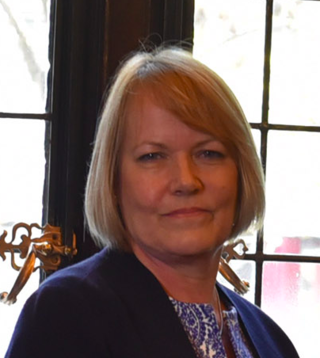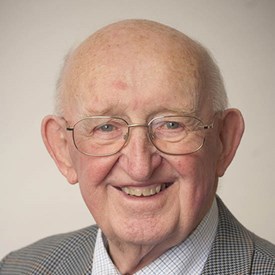Related Research Articles
Sir Richard Brook Sykes is a British microbiologist, the chair of the Royal Institution, the UK Stem Cell Foundation, and the trustees at King Edward VII's Hospital, and chancellor of Brunel University. As of June 2021, he is chair of the UK's Vaccine Taskforce, where he is responsible for overseeing the delivery of the COVID-19 vaccination programme, including preparations for booster programmes and encouraging vaccine innovation in the UK.

George Porter, Baron Porter of Luddenham, was a British chemist. He was awarded the Nobel Prize in Chemistry in 1967.

Dorothy Annie Elizabeth Garrod, CBE, FBA was an English archaeologist who specialised in the Palaeolithic period. She held the position of Disney Professor of Archaeology at the University of Cambridge from 1939 to 1952, and was the first woman to hold a chair at either Oxford or Cambridge.

Sir David Roxbee Cox was a British statistician and educator. His wide-ranging contributions to the field of statistics included introducing logistic regression, the proportional hazards model and the Cox process, a point process named after him.

Sushanta Kumar Bhattacharyya, Baron Bhattacharyya, was a British-Indian engineer, educator and government advisor. In 1980, he became Professor of Manufacturing Systems at the University of Warwick and founded the Warwick Manufacturing Group. In 2004, he was made a Life Peer and became a member of the House of Lords.
Sir James Hough is a British physicist and an international leader in the search for gravitational waves.

Dame Jane Elizabeth Francis, is the Director of the British Antarctic Survey. She previously worked as Professor of Palaeoclimatology at the University of Leeds where she also was Dean of the Faculty of Environment. In 2002 she was the fourth woman to receive the Polar Medal for outstanding contribution to British polar research. She is currently the Chancellor of the University of Leeds.

Dame Athene Margaret Donald is a British physicist. She is Professor Emerita of Experimental Physics at the University of Cambridge, and Master of Churchill College, Cambridge.
Sir Charles Herbert Stuart-Harris was an English virologist and academic who was the first full-time professor of medicine at University of Sheffield.

Duncan Dowson was a British engineer who was Professor of Engineering Fluid Mechanics and Tribology at the University of Leeds.

The Journal of Antimicrobial Chemotherapy is a peer-reviewed medical journal which covers antimicrobial chemotherapy, including laboratory aspects and clinical use of antimicrobial agents. It is published by Oxford University Press on behalf of the British Society for Antimicrobial Chemotherapy and was established in 1975. In January 2015 J. Peter Donnelly became the eighth editor-in-chief replacing Alan P. Johnson. The journal has had two previous publishers. All content is available for free after 12 months while authors also have the option to have their articles published immediately as open access.
The British Society for Antimicrobial Chemotherapy (BSAC) is a UK-based multi-professional organisation with worldwide membership for clinicians and scientists with a specialist interest in antibiotic management and therapy. It is headquartered in Birmingham, UK.
Quintin McKellar is a British veterinary surgeon and academic. In the 2011 New Year Honours list, he was appointed a CBE for services to science during his tenure as principal of the Royal Veterinary College. Since January 2011 he has been vice-chancellor of the University of Hertfordshire.
Sir Marcus Henry Richmond,, known as Mark Richmond, is a British biochemist, microbiologist and academic.
Sharon Jayne Peacock is a British microbiologist who is Professor of Public Health and Microbiology in the Department of Medicine at the University of Cambridge.
Alasdair Macintosh Geddes is Emeritus Professor of Infection at the University of Birmingham Medical School. In 1978, as the World Health Organization (WHO) was shortly to announce that the world's last case of smallpox had occurred a year earlier in Somalia, Geddes diagnosed a British woman with the disease in Birmingham, England. She was found to be the index case of the outbreak and became the world's last reported fatality due to the disease, five years after he had gained experience on the frontline of the WHO's smallpox eradication programme in Bangladesh in 1973.
Lawrence Paul Garrod, was a British bacteriologist who studied uses of penicillin. In 1929, he was a reader in the University of London and became professor of bacteriology in 1934, a post that he held until his retirement in 1961. He was a member of committees of the Department of Health, the Medical Research Council and World Health Organization.
Laura Piddock is a microbiologist, specialising in antibiotics and antibiotic resistance in bacteria. She is Professor Emeritus at the University of Birmingham, UK and also Scientific Director within the Global Antibiotic Research and Development Partnership.
Evelyn Ann Silber is an English art historian and an acknowledged specialist on 20th century British sculpture. She is an honorary Professorial Research Fellow at the University of Glasgow and is researching the marketing of modernist art in early 20th century London and the role played by dealers. Having moved to Glasgow in 2001 to assume the role of Director of the Hunterian Museum and Art Gallery, Silber continues to be based there and is an advocate for Glasgow’s cultural heritage, the conservation of the city, and its tourist industry. She is currently the Chair of the Scottish Archaeological Finds Allocation Panel.

Frank C. Odds was an English mycologist. He studied Candida albicans, establishing how modern researchers study fungal pathogens and the diseases they cause.
References
- ↑ "Garrod Lecture & Medal". The British Society for Antimicrobial Chemotherapy. 2021. Archived from the original on 2 November 2021. Retrieved 2 November 2021.
- ↑ Batten, Jack (1997). Awards, Honors & Prizes: International and Foreign 1998. Gale / Cengage Learning. p. 133. ISBN 978-0-7876-1349-5.
- ↑ Geddes, Alasdair M. (July 2017). "Dr George N. Rolinson, 16 March 1926–8 December 2016". Journal of Antimicrobial Chemotherapy. 72 (7): 1847. doi: 10.1093/jac/dkx075 .
- ↑ Rice, Louis B.; Eliopoulos, George M.; Jacoby, George A. (July 2014). "In Memoriam: Robert C. Moellering, Jr". Antimicrobial Agents and Chemotherapy. 58 (7): 3583–3584. doi:10.1128/AAC.03199-14. ISSN 0066-4804. PMC 4068561 . PMID 24798286.
- ↑ Saag, Michael S. (2014). Updates in HIV and AIDS: Part I, An Issue of Infectious Disease Clinics. Philadelphia: Elsevier. p. xiv. ISBN 978-0-323-32328-4.
- ↑ "Honours and Memberships - Professor Brian G Spratt FRS". www.imperial.ac.uk. Retrieved 5 November 2021.
- ↑ "Ian Chopra | School of Molecular and Cellular Biology | University of Leeds". biologicalsciences.leeds.ac.uk. Retrieved 5 November 2021.
- ↑ "2017 Commencement". www.sph.emory.edu. Retrieved 2 November 2021.
- ↑ "Birmingham researchers awarded the Garrod Medal and the Gilbert Blane Medal". University of Birmingham. Retrieved 2 November 2021.